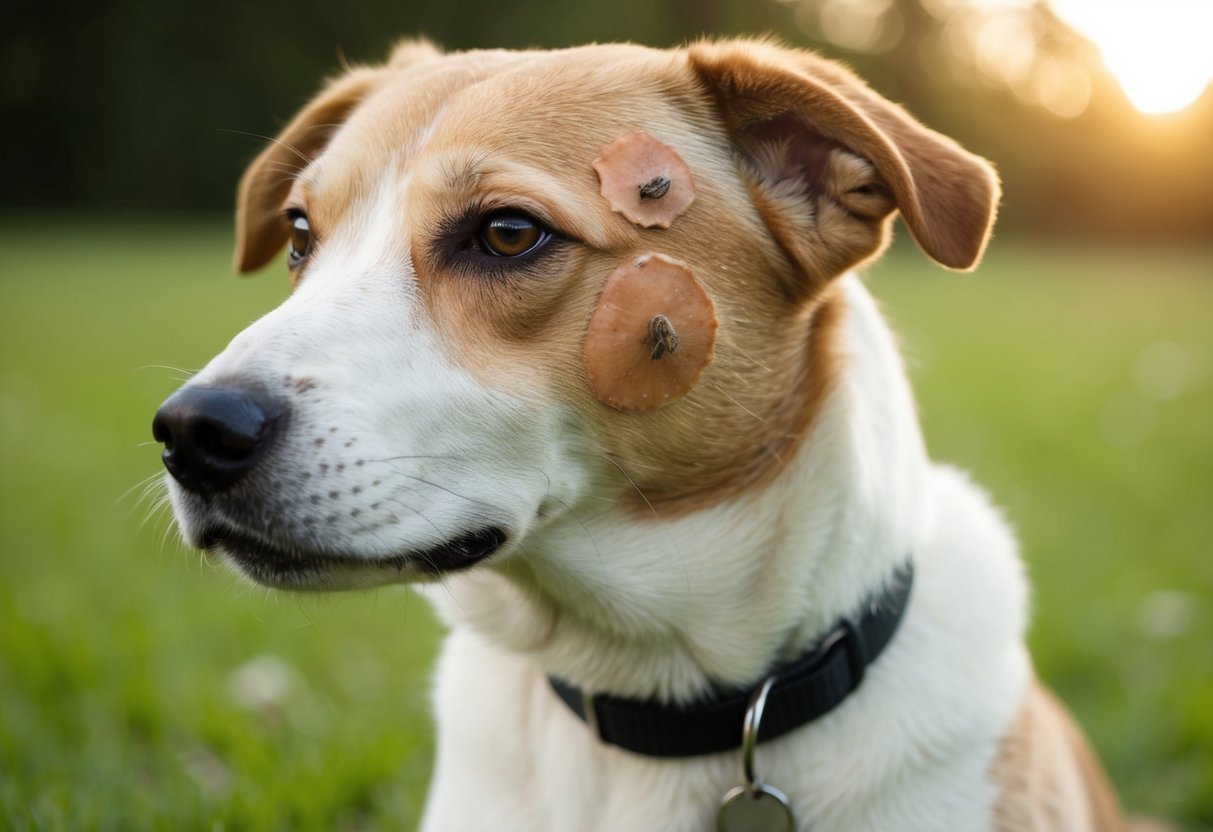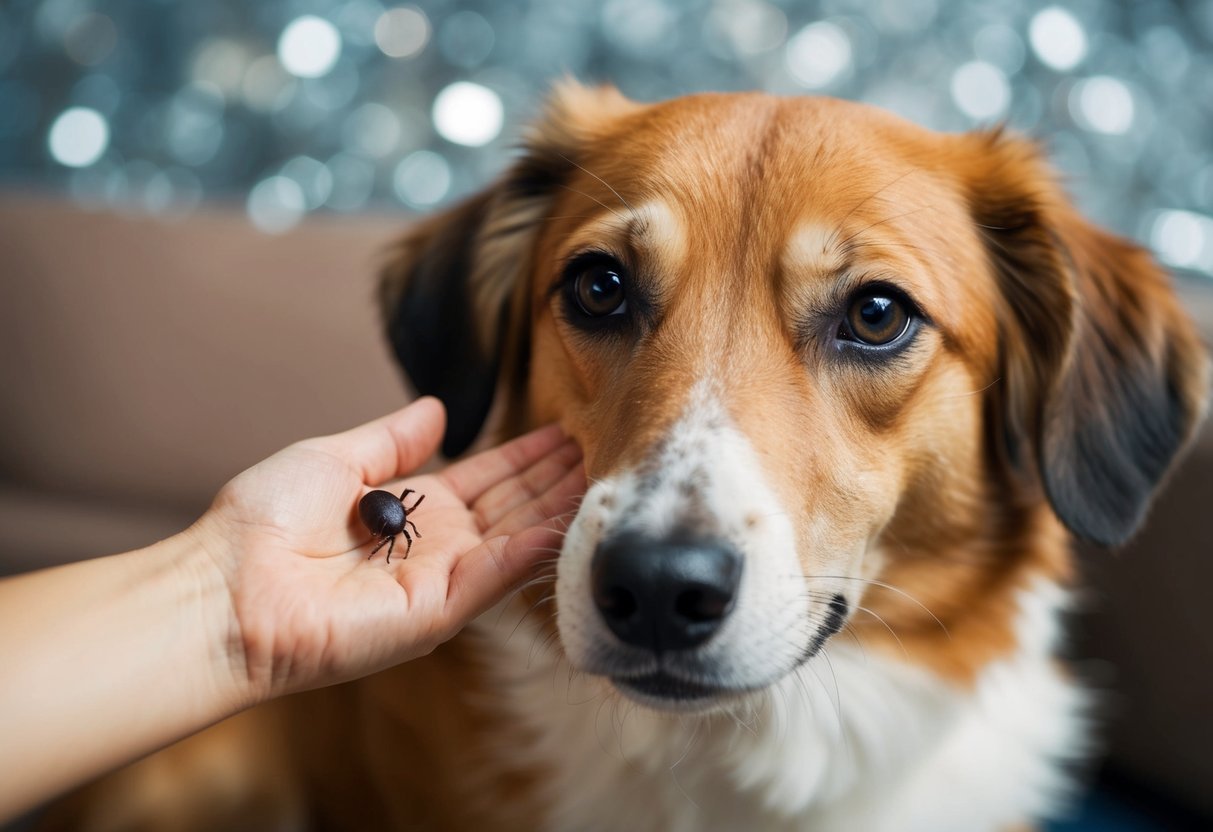As a dog parent, keeping your furry friend safe is a top priority.
Ticks can be more than just a nuisance; they can pose serious health risks if not detected early. Knowing the warning signs of a tick bite is crucial for preventing potential complications.
Unfortunately, many dog owners overlook the subtle symptoms that indicate a tick bite.
Being alert to these signs can make a huge difference.
With a little attention, you can protect your dog from the dangers that ticks bring.
1) Subtle Red Rash

You might not always notice a tick bite right away, but a subtle red rash can be a sign to watch for.
This rash often appears as small, raised spots on your dog’s skin.
It can be easy to miss, especially if your dog has a thick coat.
Keep an eye on areas where ticks like to hide, like under the collar or between toes.
If you see any redness or irritation, it could mean your dog had a tick bite.
This irritation may cause your dog to scratch or lick the area more than usual.
Don’t ignore these signs.
A red rash can also lead to infections if not treated.
If you notice a red rash, it’s best to reach out to your vet for advice.
Being proactive can help your dog stay healthy.
Regularly check your dog’s skin, especially during tick season.
This way, you can catch any issues early on and keep your furry friend comfortable.
Tiny Black Dots

When you notice tiny black dots on your dog’s skin, it’s important to pay attention.
These dots could be signs of ticks or tick scabs.
Ticks leave dark spots on the skin after they detach, which can be easy to overlook.
Sometimes, you might find small ticks that are not fully grown.
These immature ticks, called nymphs, can be as small as a poppy seed.
They are often harder to spot but can still cause issues.
If you see these black dots, check your dog carefully.
Ticks like to hide in warm areas, such as the ears, armpits, and between the toes.
Make sure to regularly examine your dog, especially after walks in grassy or wooded areas.
If you think you see a tick or scab, it’s best to consult with a vet.
They can help you identify what’s going on and give advice on treatment.
Staying on top of these signs can help keep your furry friend healthy.
Circular Bald Patches

If you notice circular bald patches on your dog, pay attention.
These patches can be a sign of various issues, including tick bites.
Ticks can cause irritation and discomfort, leading to itching and hair loss.
When ticks attach to your dog, they can create small wounds.
As your dog scratches or bites at the area, they may pull out hair, forming bald spots.
It’s important to regularly check your dog for ticks, especially after spending time outdoors.
Keep an eye out for other signs like scratching or constant licking.
These behaviors may indicate that something is bothering your dog.
A vet visit may be necessary if you spot these patches.
In some cases, allergies can cause similar hair loss.
However, if you suspect a tick bite, look for the tick itself.
Removing ticks promptly can help prevent more serious problems.
Always consult your veterinarian if you’re unsure about the cause of the bald patches on your dog.
4) Unusual Scabs

When you notice an unusual scab on your dog, it could indicate a tick bite.
Ticks can leave behind small, dark scabs after detaching from your pet’s skin.
These scabs might not seem important, but they can signal that your dog has had an encounter with a tick.
Keep an eye out for scabs in common areas like the belly or under the arms.
If the scabs look abnormal, such as being larger than usual or showing signs of infection, it’s time to take action.
You should also watch for any changes in your dog’s behavior.
If your pet seems more tired than usual or starts scratching at the scab, this could be a warning sign.
Remember to check for other signs of tick bites, like redness or swelling.
These can help you identify if your dog needs veterinary care.
It’s better to be safe and get your fur friend checked out to rule out any tick-borne diseases.
5) Constant Paw Licking
If you notice your dog licking their paws non-stop, it could be a sign of trouble.
While some licking is normal, obsessive licking might indicate discomfort or an underlying issue.
One common reason for constant paw licking is allergies.
Your dog could be reacting to something in their environment or their food.
This can lead to itching and irritation, causing them to lick.
Injuries are another reason for this behavior.
If your dog hurt their paw on a walk or has a splinter, they might lick to soothe the pain.
Check their paws for cuts, swelling, or anything stuck.
Skin conditions, like infections or eczema, can also cause persistent licking.
If you see redness, hair loss, or sores, it’s best to consult your vet.
Ticks can also lead to this behavior.
If your dog has a tick bite, they might lick their paws due to discomfort.
Regularly checking your dog for ticks can help catch issues early.
Taking note of your dog’s licking and any other symptoms can help you spot when it’s time to visit the vet.
Understanding Tick Bites
Tick bites can pose serious risks to your dog’s health.
Knowing how ticks affect dogs and where they typically bite can help you keep your furry friend safe.
How Ticks Affect Dogs
Ticks are small parasites that feed on blood from their hosts, including dogs.
When a tick attaches, it can transmit diseases that may lead to health issues.
Common diseases include Lyme disease, ehrlichiosis, and anaplasmosis.
Signs of an infection can vary but often include fever, laziness, loss of appetite, and swelling around the bite area.
If ticks are not removed promptly, they can increase the risk of these diseases.
Make it a habit to check your dog regularly for ticks, especially after outdoor activities.
Common Areas for Tick Bites on Dogs
Ticks are known to latch onto specific areas of your dog’s body.
Pay special attention to these common spots:
- Ears: Ticks can hide in the folds of the skin.
- Neck and Collar Area: This area is often overlooked during checks.
- Underbelly: A prime location due to the dog’s body touching grass or bushes.
- Between Toes: Ticks can easily attach here when your dog walks through tall grass.
- Tail Area: The fur can conceal ticks in this spot.
Regular checks in these areas can help you catch tick bites early.
If you find a tick, remove it carefully and monitor your dog for any signs of illness.
Recognizing Symptoms

It’s crucial for dog parents to be aware of subtle changes in their pets that could signal a tick bite.
By recognizing these signs early, you can help prevent more serious health issues.
Behavioral Changes in Dogs
Watch for any changes in your dog’s behavior.
If your normally playful pup seems unusually tired or lacks energy, it may be a sign of a problem.
Key changes to notice:
- Reduced Activity: Is your dog less excited to play or go for walks? This behavior might indicate discomfort.
- Irritability: If your friendly dog is acting grumpy or snaps when touched, it could be suffering from pain due to a tick bite.
- Loss of Appetite: When dogs feel unwell, they often stop eating. If your dog is refusing food, it’s important to investigate further.
Pay attention to these shifts, as they can be easy to overlook.
Subtle Skin Reactions
Skin issues may also arise from tick bites.
Ticks can irritate the skin, leading to reactions that may not be immediately obvious.
Signs to monitor:
- Itching and Scratching: If your dog is scratching more than usual, it could be a sign of irritation from a tick.
- Redness or Swelling: Look for any unusual redness or swelling at the site of a tick bite. This can indicate an allergic reaction or infection.
- Presence of a Tick: Sometimes, the clearest sign of a tick issue is simply finding a tick attached to your dog’s skin. Regularly check for these pests, especially in areas like the ears or between toes.
By keeping an eye on these symptoms, you can stay ahead of potential tick-related health issues.
Frequently Asked Questions

It’s normal to have questions when it comes to your dog’s health, especially after a tick bite.
Here are some common concerns and their answers to help keep your pup safe.
How can I spot an infected tick bite on my dog?
Look for signs like a subtle red rash around the bite area.
You might also notice tiny black dots or unusual scabs.
If your dog seems extra itchy or licks the spot a lot, it could mean something’s not right.
How quickly do symptoms show up in dogs after a tick bite?
Symptoms can appear anywhere from a few days to a few weeks after a bite.
Some dogs might seem fine at first, but then start to show signs like lethargy or loss of appetite.
Keep an eye on your dog in the days following a tick exposure.
Can ticks cause serious issues if I don’t get my dog treated?
Yes, ticks can transmit diseases like Lyme disease and Rocky Mountain spotted fever.
If left untreated, these can lead to serious health problems for your dog.
Always consult a vet if you suspect a tick bite.
Are there any specific signs I should look for to know if my pup has a tick?
You should watch for circular bald patches or constant paw licking.
If your dog has a tick, you may also see redness or swelling at the bite site.
Paying attention to these signs can help catch issues early.
What should I do if I find more than one tick on my dog?
If you find multiple ticks, it’s important to remove them as soon as possible.
Use tweezers or a tick removal tool to get them out carefully.
If you’re unsure about removal or see signs of infection, call your vet for guidance.
What’s the best way to tell if a lump on my dog is actually a tick?
If you notice a lump, carefully check the area for a tick attached to the skin.
You should see it sticking out or feel a small bump if it’s a tick.
If you can’t tell, or if the lump doesn’t go away, reach out to your vet for a proper check-up.

